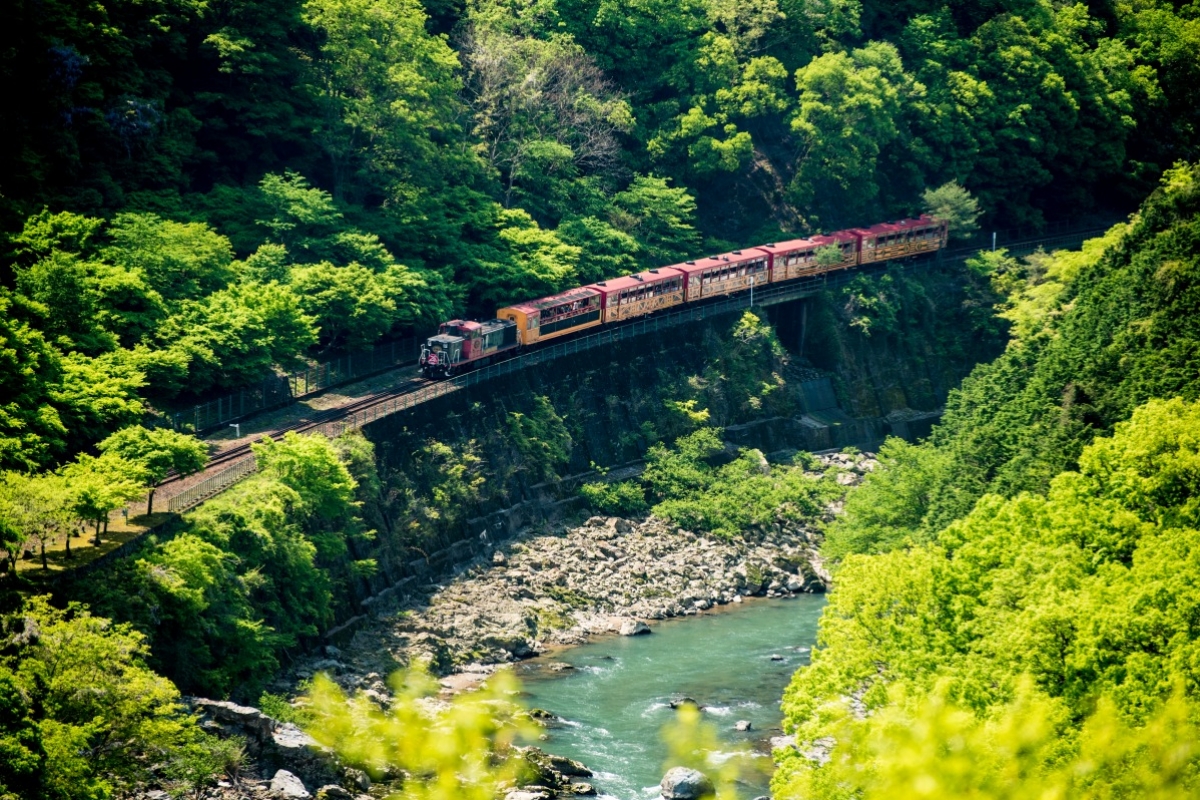In summer Kyoto, you can see many traditional Japanese scenery. If you will visit Kyoto in summer, we introduce you to 10 recommended spots you can enjoy.
Riverbed at Kamogawa (Kamogawa Nouryo-yuka)
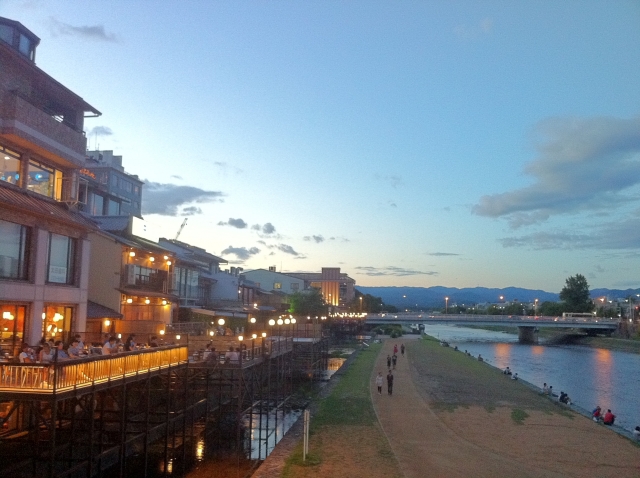
The shops lined along the Kamogawa in Kyoto, once a year, place a seat on the riverside in the hot season from May to September each year. The seat made of wood is called “Kawayuka (riverbed)”. This custom of Kyoto lined up along the river from Nijo to Gojo has been inherited from an old age.
After the rebellion of 1467-1477, the riverbank of the Kamogawa begins to change.
Wealthy merchants have started to set up theaters and tea shops there. This is the beginning of the riverbed.
In the Edo period, Ishigaki was maintained there, and a Hanamachi was formed nearby, and it became a entertainment area. It is said that at the Gion Festival, there were many visitors.
With the traditional riverbeds of Kyoto with such a long history, you can eat various foods while feeling the coolness outside at the seats facing the river surface.
There are many Japanese multi-course meals there, but you can also enjoy a variety of other dishes.
Access from Kyoto Station
Change trains at Shijo Station on the Karasuma Subway Line,
Get off at Hankyu “Kawaramachi” station
Change to the Karasuma Oike Subway Station on the Karasuma Line.
Get off at “Kyoto City Hall Mae” station on the subway Tozai Line
Get off at the city bus “Kawaramachi Gojo”, “Shijo Kawaramachi”, “Kyoto City Hall”
Gion

Gion is a Hanamachi that is lined with traditional Japanese red-patterned griddle restaurants and tea houses, and is a central city known as a leading downtown area that still represents Kyoto.
Gion, which originally prospered as the front gate town of Yasaka Shrine, still has many famous places and shops as its remnants.
You can easily get there from Kyoto Station, and it is a popular area visited by many tourists both inside and outside Japan as an area that is easy to visit.
If you are lucky, you may be able to meet Maiko on a street where you can enjoy Japanese-style scenery.
In the Gion area, there are restaurants that offer Kyoto cuisine in the parlor and a range of souvenir shops.
In addition, if you enter the alley a little, old houses are still lined up in places, and you can feel the taste of the old city.
Gion is a city where you can enjoy everything from gourmet to shopping to sightseeing.
You can enjoy the charm of Kyoto just by taking a day walk through Gion.
1 minute walk from Keihan Gion Shijo Station
A 5-minute walk from Hankyu Railway Kawaramachi Station
Nishiki market

Kyoto’s kitchen with a 400-year history, Nishiki market, Kyoto’s seasonal ingredients and Kyoto vegetables, Kyoto pickles, Kyoto pickles and yuba, chopsticks, salmon roe, chopsticks, chopsticks, dried fish, dried food, tea, confectionery, sushi and tofu There are many stores that you can enter and sample.
You can also eat the food you bought at the store.
Tofu and Kyoto pickles are especially popular with tourists. With a wide variety of food, you can also enjoy Kyoto’s unique food culture.
The shopping district, lined with seasonal produce, has the charm that you will never get bored with.
Nishiki Market is located in the Gion area, with easy access from Kyoto Station.
Eating and drinking while walking is prohibited, so if you want to eat the food you bought immediately, please eat in front of the shop you bought.
Address : 609 capital city town, fuji capital street, Chukyo-ku, Kyoto City, Kyoto Prefecture
2 minutes on foot from the city bus 5 system “Shijo Takakura (Daimaru department store front)”
3 minutes walk from Shijo Station on the Karasuma Subway Line
A 10-minute walk from “Kyoto City Hall-mae” Subway Tozai Line Station
3-minute walk from Hankyu Kyoto Line Karasuma Station
A 4-minute walk from Hankyu Kyoto Line Kawaramachi Station
10 minutes walk from Keihan Main Line Shijo Station
A 15-minute walk from Keihan Main Line “Sanjo” Station
Yasaka shrine

Shijo Dori is one of the main streets that run through the city of Kyoto from east to west. Yasaka Shrine, located at the starting point of the east, is a representative of Yasaka Shrines around the country and about 2,300 shrines that worship the God of Suzanowomikoto.
When the epidemic spread in 869, people prayed at this shrine, and the Gion Festival, one of the three major traditional Japanese festivals, began.
The “Honden” called “Gion-making”, designated as an important cultural property is an unusual form that can only be seen here.
Yasaka Shrine, which is still well-known as a god of amulet and marriage, can be visited even at night for 24 hours.
Address : 625 north side, Gion-cho, Higashiyama-ku, Kyoto City, Kyoto Prefecture
A 5-minute walk from Keihan Gion Shijo Station
8 minutes walk from Hankyu Kawaramachi Station
15 minutes by car from JR Kyoto Station
Take city bus No. 206 from JR Kyoto Station and get off at a short distance
Kiyomizu-dera (Kiyomizu temple)
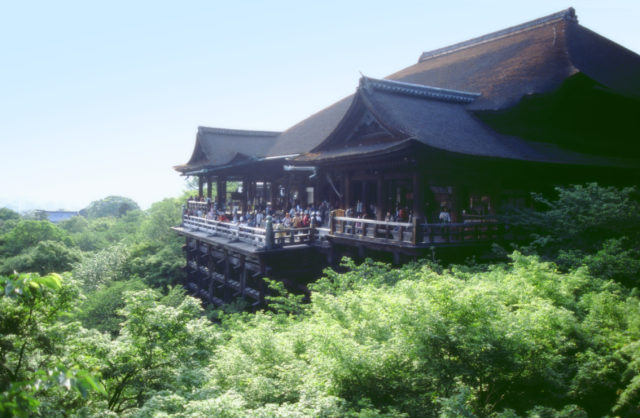
Kiyomizu-dera is a historical temple built on the middle of Mt. Otowa in Higashiyama, Kyoto. It is said that the foundation was older than the Heian-Kei capital city and was opened in 778.
Kiyomizu-dera was originally called “Kitakanonji”, but the water flowing out in the precincts was sanctified as the golden long-lived water of the Kanon faith, and “Shimizu” became known to the general public as “clean water,” It has been changed to “Kiyomizudera”.
The water from which Kiyomizu-dera originated is still popular with tourists as the famous water of Otowa Falls.
The main attraction of Kiyomizu-dera is the main hall that is famous for the stage of Kiyomizu. The height from the cliff is 18m, and Kyoto city can be overlooked from the stage.
Kiyomizu-dera is in the middle of Otowa-san, which climbs Kiyomizu-zaka, about 1 km from Higashi-Oji-dori. Kiyomizu-zaka is crowded with many souvenir shops.
On the way to Kiyomizuzaka, Sannenzaka and Ninenzaka are in contact, forming a major tourist attraction in Kyoto.
Address : 294 Kiyomizu, Higashiyama-ku, Kyoto City, Kyoto Prefecture
Access
<From JR Kyoto Station>
Kyoto city bus 206 system Higashi-Samdori Kita-Daichi bus terminal bound, 100 system Kiyomizu-dera Gion Go to Ginkakuji
10 minutes on foot from “Gojo Saka”
Kyoto bus (services only on weekends and holidays) 18 trains, 10 minutes walk from “Gojo Saka” for Ohara
<From Hankyu Railway Kawaramachi Station (Shijo Kawaramachi), Keihan Railway Gion Shijo Station>
Kyoto city bus 207 system ・ Tofukuji ・ Kujo car park for “10 minutes walk from” Kiyomizu ”
10 minutes walk from “Seido” or “Gojo Saka” with Keihan Bus 83, 85, 87, 88
A 25-minute walk from Keihan Electric Railway “Shimizu Gojo Station”
<From Keihan Electric Railway Shichijo Station>
Kyoto City Transportation Bureau (city bus) 206 system · Higashisandori Kitadaiji bus terminal for 100 system Kiyomizudera Gion · Ginkakuji for “10 minutes walk from Gojo Saka
Kifune shrine

Image source : http://photo53.com/
Kibune Shrine is a shrine that sits in the valley between Mt. Kifune and Mt. Kurama. The founding age is unknown, but it is said that it has been a place of faith before history.
Kifune Shrine is worshiped as a water god “Otakaka no kami” and has long been worshiped as a god of prayer and rain. There is faith from people in the food and cooking industry and businesses dealing with water all over the country.
There is also an anecdote in which the female poet of the Heian period, Izumi Shikibu, visited the shrine and the prayer for reunification with the dissatisfied husband was fulfilled. As a result, Kifune Shrine attracts great reverence from younger generations as a power spot for marriage.
You can drink the water at the shrine that flows from Kifne, which is the source of water in Kyoto.
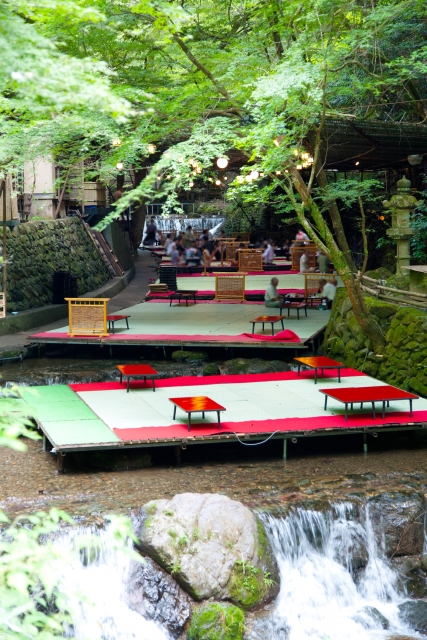
The riverbed around Kifune Shrine is also famous.
The traditional summer riverbed in Kansai is called Kawadoko in Kifune, not Kawayuka.
Kifune’s riverbed has an average temperature of 23 degrees, even 10 degrees below that of the city of Kyoto, even in the hot summer sun.
As soon as you sit down on the Kifune riverbed, you will feel cool.
From the floor prepared just above the river surface, which is rare in Japan, you can see a large two-tiered waterfall close up.
The cool breeze flowing through the rock and the sound of the water hitting it will be soothing that you will be healed just by listening to the sound. Even in the hot summer of Kyoto, only here is the coolness of the separated world, an exceptional space with a fresh air flow.
Address : 180 Kurama Kifunecho, Sakyo Ward, Kyoto City, Kyoto Prefecture
Access
A 30-minute walk from Kashiyama Train “Kifunaguchi”When using a bus from Kifuguchi Station, transfer to Kyoto bus (No. 33) from Kifuguchi Station and get off at “Kifune” station for 5 minutes
<Access from Kyoto Station>
From Kyoto Station to Demachiyanagi Station on JR Nara Line and Keikyu Main Line. From Demachiyanagi Station, transfer to Kashiyama train to Kifuguchi. 30 minutes walk from Kifunaguchi Station
Ginkaku-ji
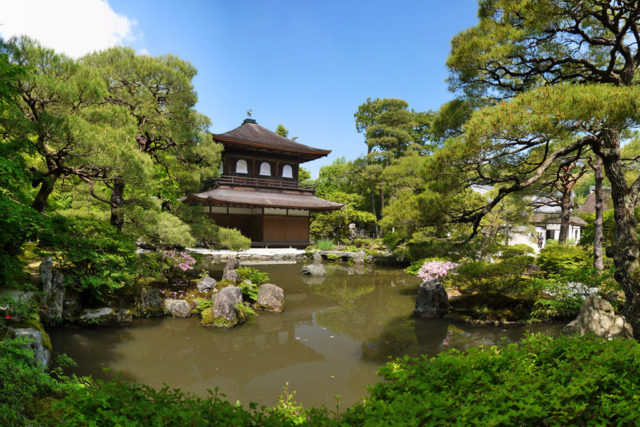
Image source : http://photo53.com/
Ginkaku-ji is a representative temple of Kyoto architecture along with Kinkaku-ji, and its official name is Jisho-ji.
Ginkakuji was founded by the 8th Shogunate Muromachi Shogunate, Yoshimasa Ashikaga, who built Higashiyama Sanso, a representative of Higashiyama culture, referring to Kitayama Sanso (Kinkakuji) built by his grandfather, Yoshimitsu Ashikaga.
After Yoshimasa’s death, it became a temple in Rinzai, and named ‘Jishoji’after Jishoin Temple in Yoshimasa.
Yoshimasa, who became a 9-year-old family general and a 15-year-old general, took over his life and projected all of his sense of beauty, creating a structure that reflects the beauty of the simple beauty that is the essence of Higashiyama culture.

Image source : http://photo53.com/
Yoshimasa Ashikaga is a well-known cultural person who has supported many cultures such as tea ceremony, flower arrangement, architecture, painting and entertainment.
In particular, the garden in the back mountain of Ginkakuji is a pond fountain swimming garden which is supposed to be taught by Yoshimasa himself. It is designated as the country’s special scenic spot in the garden that reproduced mountains, small islands, bridges, etc. around a large pond and reproduced the scenic beauty of each part.
There are many other beautiful gardens in Kyoto, but the gardens of Ginkakuji are beautiful with a vermilion and greenery and are worthwhile.
Ginkaku-ji has been sending dramas of Yoshimasa’s spirit, which can be regarded as beauty seekers, in the modern world five hundred years later.
Address : 2 Ginkakujicho Sakyo Ward Kyoto City Kyoto Prefecture
Access
After getting off the Keihan train “Demachiyanagi”, get on the city bus and get off at “Ginkakujido” and then walk about 10 minutesFrom Kyoto Station, get on City Buses 5 and 17 and train No. 17 and 203 and get off at Ginkakuji Dori or Ginkakujimae, and a 5-minute walk to the east.
Philosopher’s path (Tetsugaku no Michi)

Image source : http://photo53.com/
Philosopher’s path is a footpath of approximately 2 km from the foot of Higashiyama, Sakyo-ku, Wakaoji Shrine to Honen-in and Ginkaku-ji.
It is said that Ikutaro Nishida, a philosopher, took a walk and thought, and this name was given. It was also selected as one of the top 100 roads in Japan.
There are cherry blossoms in full bloom in spring, fresh green and shade in summer, autumn leaves in autumn, and snow landscapes in winter, a path where you can enjoy the taste of each season.
When walking the Philosopher’s path, you will often see pretty cafes there. You will feel thirsty if you take a walk while watching the beautiful tree-lined and hydrophobic flow.
It is a great luxury to have a good coffee in the cafe while looking at the rich nature on the Philosopher’s path.
City bus Nanzen-ji, Eikan-do
City bus Ginkakujimae
Takebayashi and Sagano Trolley train in Arashiyama

Image source : http://photo53.com/
Arashiyama is a tourist destination representing Kyoto. A bridge called “Togetsukyo” that spans the Katsura River is a symbol of Arashiyama.
The most popular spot among Arashiyama is the bamboo forest that extends to Sagano, north of Togetsu Bridge.
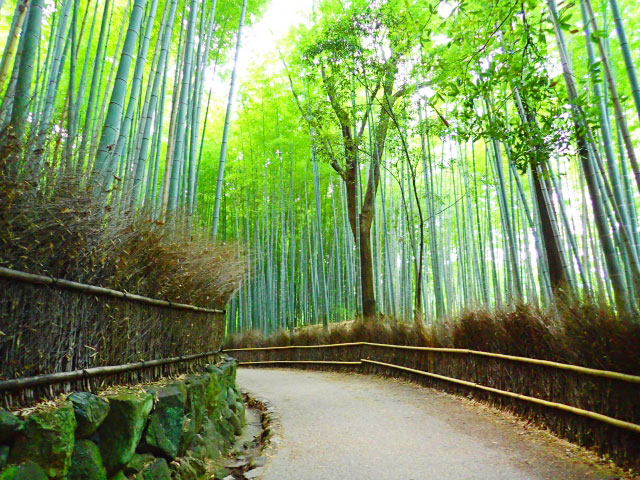
In the area where tens of thousands of bamboos grow thick, small diameter is stretched like sewing a bamboo grove, and you can feel the taste of Heian era. In summer, you can feel the coolness by playing bamboos that make a noise when the wind blows.
Running along the Hozu River, upstream of the Oigawa River, where the Togetsu Bridge hangs, is the Sagano Trolley Train.

It is a sightseeing train that runs from Trolley Saga Station to Trolley Kameoka Station, and you can enjoy cherry blossoms in spring, fresh green in summer, autumn leaves in autumn, snow scenery in winter, and views of Hozukyo in each season.
Address : Ukyo Ward, Kyoto City, Kyoto Prefecture
Access
From JR Kyoto Station to Arashiyama (Togetsubashi)
About 20 minutes on foot to Togetsu Bridge from JR Ayano Line (Sanin Line) “Kiri Arashiyama Station”
※ It takes about 15 minutes to get on the train from Kyoto Station.
The Hozu River descent

The Hozu River descent is a thrilling downfall that takes about 2 hours down a mountain stream about 16 km from Tamba Kameoka to Kyoto’s scenic scenic Arashiyama.
A skilled boatman maneuvers with a helm, a rudder, a whistle, and slips through the rocks. Usually, there are three boatmen, but depending on the wind and water volume, it may be operated by four or five people.
Before the city was built in Kyoto, people used to use the water of the Hozu River to transport supplies to downstream Kyoto and Osaka from the ancient times when the city was in Nagaokakyo city. It is so-called water transportation.
Tamba’s abundant, high-quality wood, grains, and charcoal were transported to Kyoto by water transportation until around 1955, but by the opening of the San-in line in 1832 and by the development of post-war truck transportation, the use of water transport by barge gradually disappeared.
However, the natural beauty of the Hozugawa Canyon is wonderful throughout the seasons.
With a huge rock, going mountains, splashing and falling water, and mysterious mirror-like coral, the landscape attracts people.
Therefore, the river going down with tourists as a cruise ship started from around 1868. Now, this sightseeing boating has become popular with tourists from home and abroad.
Access
8-minute walk from JR Kameoka Station to Hozu River descent boarding station
